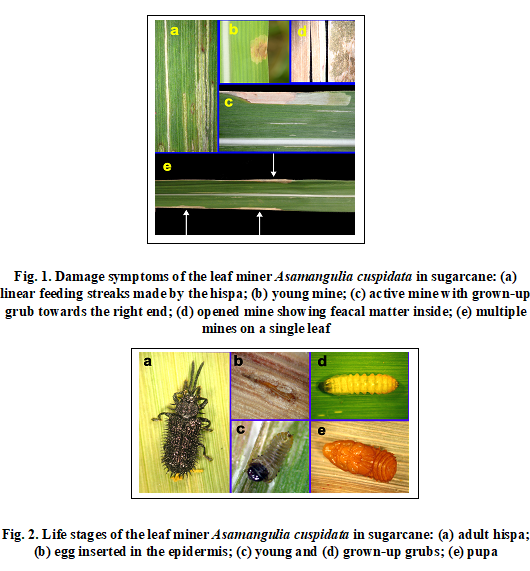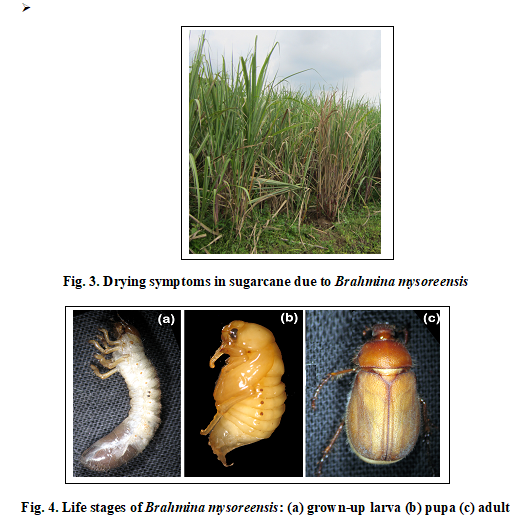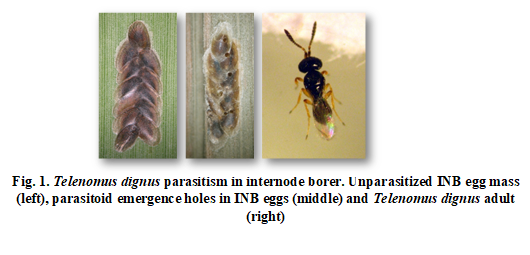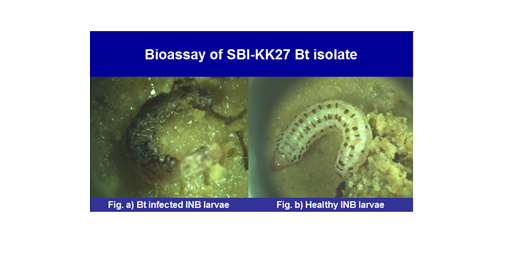Recent Achievements - Entomology
New Findings
Leaf Miner Occurrence in Sugarcane
- The leaf miner Asamangulia cuspidate Maulik (Coleoptera: Chrysomelidae: Cassidinae: Hispini) on sugarcane was observed at Coimbatore .(Fig 1 & 2).

♠ Systematic observations revealed low levels of incidence and intensity, the highest mean attack rates being 4.18% on plant basis and 12.41% on leaf basis. Mean mined leaf area showed a high of 4.24 sq. cm and it constituted 1.28% of the total leaf area. Cross-sections of young and mature mines indicated feeding on softer tissues by the solitary grub in the early stages, but extensive mining by the grown-up grub leading to complete drying of the mined area.
♠ A new species of leaf miner Aphanisticus aeneus Kerremans (Coleoptera: Buprestidae) has been observed to occur on Saccharum spp. Observations on the feeding pattern, biology and infestation levels in different Saccharum spp. have been made.
♠ The white grub Brahmina mysoreensis Frey was recorded for the first time on sugarcane in India. The pest damaged roots causing typical withering and drying symptoms in 5-7 month old crop in Villupuram district.(Fig.3& 4)

♠ Cnaphalocrocis ruralis, a minor leaf folder of paddy, was recorded on accessions of Erianthus spp.at SBI RC, Kannur, Kerala. The leaf folder, though noticed a few years back, has started proliferating in the recent years. The larvae cause characteristic injury by feeding on chlorophyll-bearing tissues leading to white transparent streaks on leaf blade. Grown-up larvae fold the leaf longitudinally holding the edges in place by bands of silk thread at regular intervals,(Fig.5).Leaf fold length was positively correlated with the number of webs.

♠ Infestation rates of Cnaphalocrocis ruralis on cane basis were higher than the intensity on leaf basis and the two parameters showed variable relationship in different years. Infestation parameters showed variation among the three observation years.
♠ Grubs mine the leaves on the lower surface just above the epidermis forming a linear channel. Another leaf miner species causing slightly different symptoms has also been observed on commercial cultivars of sugarcane. The larva produces small blotches on the leaf unlike the long serpentine mines caused by A. aeneus.
♠ The insect is also a new record belonging to Aphanisticus genus but its species identity needs to be ascertained. Both the leaf miner species have been observed to be of sporadic occurrence at negligible levels. Regular monitoring is being done to determine their pest status.
Host plant resistance
♠ Accessions of four Saccharum spp. were screened in the field against pink borer Sesamia inferens (Walker). Saccharum robustum, S. barberi and S. sinense showed accessions that were highly resistant (0.0% incidence) whereas S. officinarum did not have any. Overall, S. robustum and S. barberi accessions have good potential to serve as sources of resistance to pink borer.
♠ When four Saccharum spp. were screened against internode borer, S. robustum showed the lowest borer incidence. Percent deadhearts did not differ amongst the four Saccharum spp. Of the 171 accessions evaluated, 29 (16.9%) were resistant, 39 (22.8%) moderately resistant and 103 (60.2%) susceptible to the borer. In S. robustum, nearly half (44.5%) the accessions emerged as resistant.
♠ Plant morphological characters, yield and quality parameters of the four Saccharum spp. did not show clear-cut relationship with the three infestation parameters of internode borer.
♠ Erianthus accessions (74) assessed for Cnaphalocrocis ruralis infestation index in three study years showed incidence in at least one experimental year suggesting lack of immunity. A large proportion (85.1%) of accessions was in the low and moderate categories whereas 14.9% accessions were in the high incidence category.
♠ Leaf area of Erianthus spp. accessions was not related to infestation rates of cane or leaves but positively and significantly related to infestation index of the leaf folder.
♠ Studies with proteinase inhibitors (PIs) from meristem and stalk tissues of six selected E. arundinaceous genotypes viz., IK 76 84, IJ 76 400, IJ 76 364, ERI 2798, Fiji 55 and IJ 76 370 indicated that apical meristem PIs significantly inhibited the midgut proteinases of shoot borer and internode borer to >70% and >60%, respectively. Apical meristem PIs in the genotypes IJ 76 370, Fiji 55 and IJ 76 364 recorded highly significant reduction of proteinase enzymes of shoot and internode borers. The highest protease inhibition of 66.34 and 64.11% was observed in the stalk tissue PIs of IJ 76 370 and IJ 76 364, respectively against shoot borer. However, none of the stalk tissue PIs of E. arundinaceous were effective against midgut protease of internode borer.
♠ A simple correlation analysis performed to determine the relationship between PIs of exotic clones with field incidence of shoot borer showed that apical meristem PIs were negatively correlated with field incidence of ESB.
♠ The possibility of some of the sugarcane plant phenolic acids acting as phagostimulants/deterrents to internode borer has been observed in HPLC analysis of samples from healthy stem tissues of sugarcane hybrids with low/high internode borer susceptibility.
♠ A practical pot culture protocol for evaluating genotypes against white grubs has been developed. Several exotic clones have been screened and rated against this pest using this method.
♠ Several exotic clones have also been rated for multiple pest reaction under field conditions.
♠ In laboratory studies on comparative biology of shoot borer on resistant Erianthus clones and the hybrid Co 86032, larval period was longer and weight was lower in the former than in the latter.
Biological Control
- One apparently new Bracon sp. (Hymenoptera: Braconidae), two Pediobius spp. (Hymenoptera: Eulophidae) and one Eurytoma sp. (Hymenoptera: Eurytomidae) (Fig. 1) were recovered from the leaf miner Asamangulia cuspidata. While Bracon sp. contributed 70% to the overall parasitism rate of 39.3%, the remaining parasitoids accounted for 30% with likely hyperparasitism among them.

♠ Monitoring of internode borer (INB) egg parasitoids by collecting egg masses from sugarcane crop system at fortnightly intervals over the last three years indicated predominance of the parasitoid Telenomus dignoides.The parasitoid was active throughout the year, except during summer months. Parasitism rates generally ranged 33.3-100.0% on egg mass basis and 100.0% within the egg masses. Adult emergence from individual egg masses ranged 33.3-100.0%.


Insect Bar Coding
♠ DNA barcodes were developed for economically important insects in the sugarcane ecosystem. viz., root borer Emmalocera depressella, shoot borer Chilo infuscatellus, internode borer Chilo sacchariphagus indicus, stalk borer Chilo auricilius, top borer Scirpophaga excerptalis and pink borer Sesamia inferens.
♠ DNA barcodes have also been developed for the sucking pests viz., Melanaspis glomerata, Aleurolobus barodensis, Neomaskellia bergii, Melanaphis sacchari, Hysteroneura setariae, Tetraneura javensis, Pyrilla perpusilla, Abdastartus atrus and Proutista moesta.
♠ We have also developed DNA barcodes for potential natural enemies viz., Epiricania melanoleuca, Dipha aphidivora, Micromus igorotus and Sturmiopsis inferens. The DNA barcodes of all the species are exactly 658 bp in size. In case of scale insect Melanaspis glomerata and whitefly Aleurolobus barodensis the barcode length is of 649bp in size.
♠ These DNA barcodes are either first ever barcodes for some species or the best barcodes without loss of a single base in the COI sequences. These barcodes will serve as ideal molecular diagnostic kits and aid in exploring of cryptic species among the diverse populations that exist in the tropical and subtropical sugarcane ecosystems of the country.
Insect Chemical Ecology
♠ Sugarcane plants treated with geranyl acetate to induce resistance against internode borer were found to be attractive to the braconid parasitoid Cotesia flavipes plants suggesting the chemical’s secondary role as an attractant.
♠ Heneicosane and its isomer n-heneicosane, known parasitoid attractants, have been detected in the volatiles collected from internode borer infested sugarcane plants indicating possible chemical mimicry to attract the parasitoid of this borer.
Insecticide Toxicology
♠ Dissipation kinetics of insecticides viz. chlorantraniliprole, clothianidin, imidacloprid, thiamethoxam and bifenthrin have been studied in detail. Clothianidin was observed to be more persistent in the soil as compared to other molecules, which are under recommendation and large-scale use.
♠ Imidacloprid 70 WS was found to persist in the setts for more than 120 days after sett-treatment. Phorate was found to persist in the soil for about a month and its sulfide and sulfone metabolites reached below their detectable levels only after 105 and 120 days of application, respectively. The prolonged efficacy of phorate is therefore, attributed to longer persistence of its sulfoxide and sulfone metabolites.
♠ Carbofuran gets metabolized into 3-hydroxy carbofuran in the soil of tropical sugarcane field. The parent compound carbofuran was observed to persist more in the soil (up to 105 days) as compared to its metabolite (30 days).
♠ Methods have been developed to quantify trace amounts of organophosphates and their major metabolites (acephate, chlorpyrifos, dichlorvos, monocrotophos, malathion, malaoxon, phorate, phorate-sulfoxide, phorate-oxon, phorate-sulfone and quinalphos) in cane juice.
♠ Methods have also been developed to detect trace amounts of fipronil and its metabolites in sugarcane juice. This ensures food safety to the consumers. The methods are in compliance with European Commission’s Regulation for Trace Residue Analysis.
♠ A rapid analytical method has been standardized to determine the residues of the insecticide chlorantraniliprole in soil. The persistence and dissipation kinetics of the insecticide applied as soil drench in sandy loam soils of sugarcane ecosystem were also studied by employing this analytical method.
♠ A novel, simple, sensitive and rapid analytical method has been standardized for simultaneous determination of fipronil and its metabolites in sugarcane juice for the first time.
Contact Address
-
ICAR-Sugarcane Breeding Institute
Veerakeralam,
Coimbatore 641007
Tamil Nadu. - Phone: 0422 - 2472621
- Email: director.sbi@icar.gov.in
- GST Number 33AAAAD2962K2ZT
Our Visitor Count







